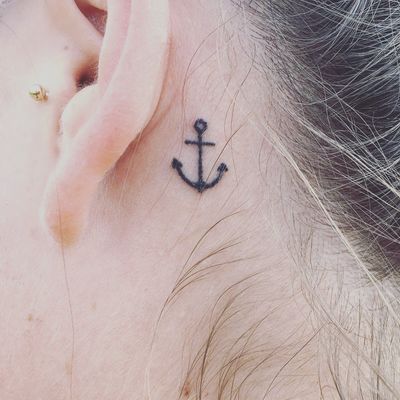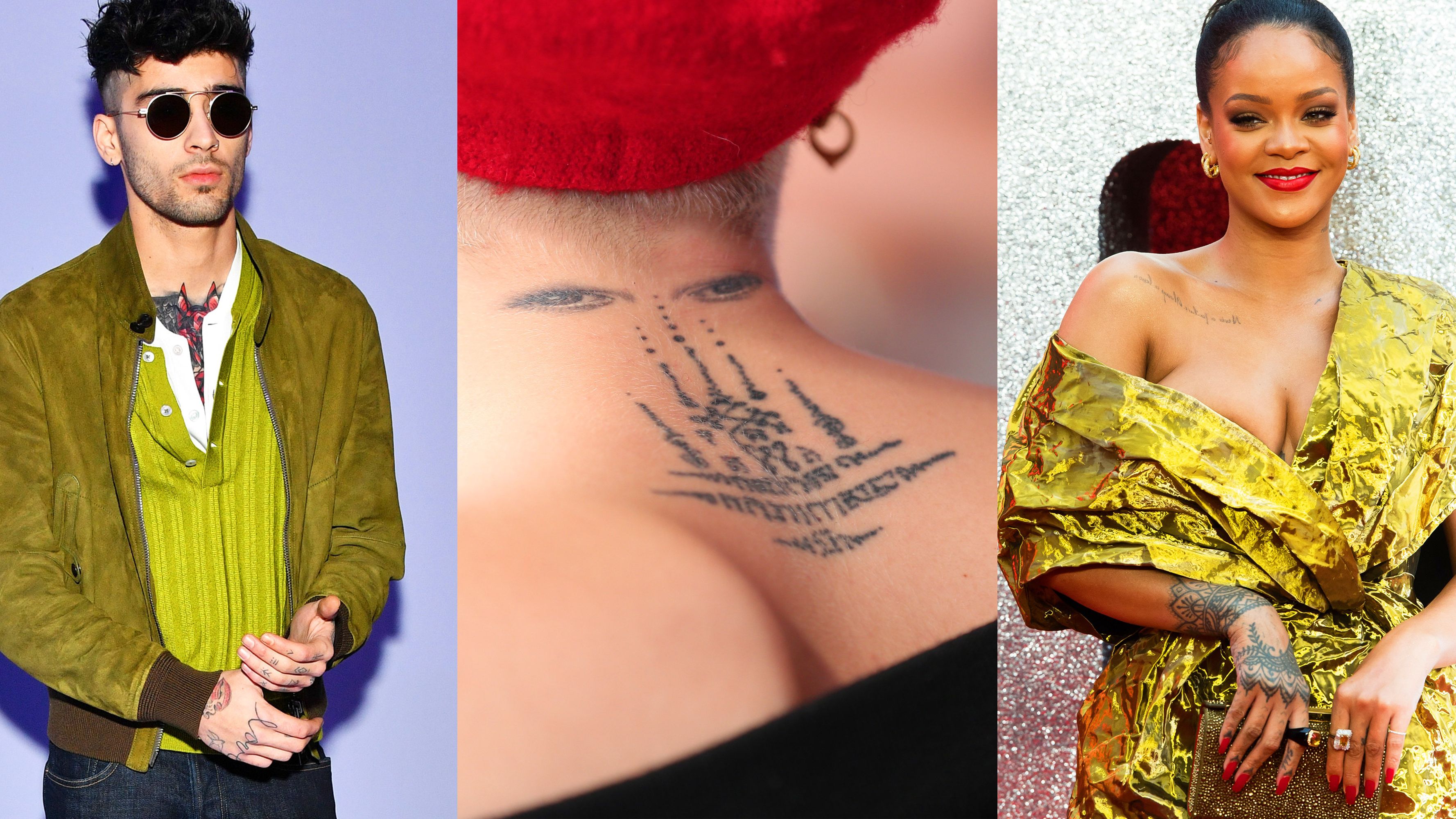The Pretty—but Potentially Dangerous—Trend of DIY Tattoos
Many millennials aren't getting their first tattoo at a traditional parlor for hundreds of dollars—they're getting it from a friend at home for free.

Emma Hamilton's first tattoo was supposed to be a pair of cherry blossoms, delicate and dainty, like two daisies side by side. It didn't turn out quite like she expected. Then again, she knew she was taking a risk when she decided to let her (now ex) boyfriend—who is not a tattoo artist—execute the ink. "The lines are too thick and don't look like how I drew them," she says. "He was an asshole, too."
Despite the outcome, 27-year-old Hamilton didn't head to a professional when she wanted more body art. She did her second tattoo herself: a lightning bolt she's since given to five others. Her third? "It's a '13' on my right side, where my boob meets my ribs. It came out nice and clean, especially considering my friend was tripping balls when he did it."
They're a stylish embrace of economic changes and an eff-you to the idea that to be beautiful things must also be perfect.
Increasingly, millennials like Hamilton are ditching intimidating tattoo parlors that charge $100—minimum—for a teeny crescent moon in favor of inking each other in their own homes, despite health risks and questionable legality. Tumblr is full of examples of the handiwork. Instagram accounts dedicated to the trend have tens, even hundreds of thousands of followers. Kesha, Brooke Candy, and Miley Cyrus all have amateur body art. (Cyrus's is a smiley face done by her friend Cheyne Thomas; she gave him one in return.) It's the intimacy that's part of the appeal: "It can give the tattoo meaning when it's someone close to you giving it," Hamilton explains.
Traditional tattoos performed in established shops are usually done in professionally sanitized conditions with a tattoo machine, a handheld device that uses electricity to rapidly move multiple needles in quick succession across your skin. DIY versions are often done in a style known as "stick and poke," with a single needle dipped in ink. A new puncture is made for each dot of the tattoo—a much slower and sometimes more painful process.
New York City-based artist Rachel Howe, a leader of the trend, speculates that part of the reason for its rise in popularity was a bad economy—millennials can't afford steep salon prices, so they tattoo one another with inexpensive supplies. "It's way cheaper than going to a tattoo shop," Hamilton agrees. Like letting your dark roots show, the jagged, give-no-shits aesthetic of stick and pokes can be seen as a stylish embrace of economic changes, while also being an eff-you to the idea that to be beautiful things must also be perfect.
Stick and pokes began (and still are done) between friends, but not all fans care about the intimate experience. Many come for the aesthetic. When done correctly, DIY tattoos can be delicate and feminine. Artists specializing in the style are gaining notoriety and, ironically, a trend that originated largely because it saves money and can be done at home is now highly sought after in professional shops for professional prices. But few professionals are there yet. "It's just a handful of people including myself who have honed their skills to make them delicate and precise," says Tati Compton, a well-known tattoo artist in Los Angeles, adored for her occult-inspired style.
Machine tattoos can appear like they came straight off the wall of a tattoo shop (and often do).
She originally envisioned her studio as a place for female tattoo novices to come for softer, smaller designs. "I had an idea that girls who are intimidated by tattoo shops could come to me," she says. "Machine tattoos can look almost too perfect, like a stamp. I like stick and pokes because they're organic. You can tell that they happen in a moment in time." Machine tattoos can appear like they came straight off the wall of a tattoo shop (and often do). With stick and poke, even if you request the same design as someone else, through the nature of the by-hand process, each tattoo will look unique.
Get exclusive access to fashion and beauty trends, hot-off-the-press celebrity news, and more.
Not to say they all turn out well. Compton observes that many stick and pokes are "bled out"—meaning the ink has seeped out of the initial design to the surrounding area—and "gnarly looking." And for good reason: Even when tattoos are lovingly done by well-intentioned friends, complications are common.

"The heat needed to sterilize needles is far greater than simply running a sewing needle under a lighter," explains Compton. Pre-sterilized tattoo needles can be purchased online, but doing so doesn't mean you're in the clear. Ink contamination is a concern, particularly from Sumi ink, the kind often used for DIY tattoos (it's found at craft shops or on Amazon and is meant for drawing or lettering). "We've seen cases of the ink having a type of bacteria called mycobacterium, which is related to tuberculosis," says Amesh Adalja, MD, a clinical assistant professor of emergency medicine at the University of Pittsburgh School of Medicine. Additionally, red ink is known to cause allergic reactions. When Jack* gave himself a tattoo of a slice of pizza, the pepperonis became infected. "Nothing else in the tattoo was raised like the red parts were," Jack says. He realized the red ink he used contained mercury sulfide.
Shared needles also pose a massive health risk. "If you share needles, you could infect yourself and others with HIV, hepatitis B, hepatitis C, and other infectious diseases," says Celine Gounder, MD, an infectious diseases specialist in New York City. And then there's the issue of legality: Nearly half of states require anyone giving a tattoo to be licensed or certified by the Department of Health or similar agency and follow certain safety and sanitation standards. That means that getting your body art from a friend—or doing it yourself—could be a crime.
RELATED STORIES



And when you're not getting your ink advice from a pro, you're on your own for aftercare, too. Keeping the area clean is paramount for preventing infections, as anyone who has even a perfectly executed traditional tattoo will tell you. Even then, shit happens. "I fell through a bad piece of wood on a friend's deck two days after getting my tattoo," says Karissah Peterson, 32, who was given a stick and poke tat by a friend at a going-away party. "It got pretty infected." (She and the tattoo are fine now.)
But all the DIY risks aren't stopping the young women who want them—whether for the style, the cost, or the experience. "You can't compare the two," Peterson says of professional tattoos and the homemade kind. "It's its own thing."
*Names have been changed.
Follow Marie Claire on Facebook for the latest celeb news, beauty tips, fascinating reads, livestream video, and more.